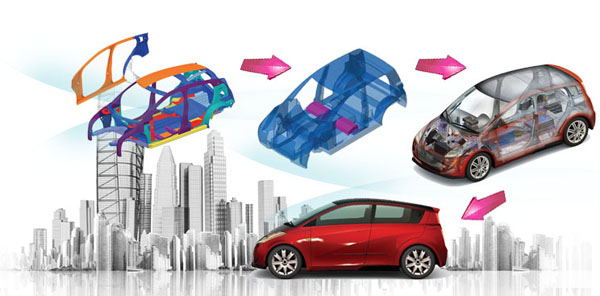Cars
According to IEA (International Energy Agency) statistics about 20% of the global carbon dioxide emissions comes from transportation, of which 80% is from by vehicles using gasoline or diesel such as automobiles and motorcycles. The rest is from trains and planes, etc. That is about 16% of emissions are produced by vehicles using gasoline and diesel. As the effect of global warming worsens day by day low carbon transport must inevitably become the focus of global attention.
In order to achieve the goal of low carbon transport most of the proposed solutions are aimed at modifying the vehicles themselves. Hence, in recent years China Steel Corporation (CSC) has actively dedicated research into steel materials. At the present stage CSC together with local and overseas steel companies has developed a “light-weight automobile body.” The lighter automobiles become, the less GHG emissions they produce. A heavier body would consume more oil and energy, but a lighter body can save energy. Another commonly proposed idea is electric vehicles. The power for electric vehicles comes from electricity which is clean and low-pollution. Generally electric vehicles use a light-weight automobile body design which will both save energy and reduce carbon emission. This will also contribute to the goal of low carbon transport.

 Since 1998 CSC has paid close attention to the areas of “light-weight automobile bodies” and “electric vehicles”, and has been engaged in the relevant research. CSC participated in the FSV (future steel vehicle) project of in 2008 initiated by the WAS (World Auto Steel) of the World Steel Association. On May 18 2011 the WAS and 16 member steel mills simultaneously published research results from the last three years. The FSV project aims to develop a light-weight steel body for electric automobiles in 2015~2020. High strength steels were used for the design and manufacture of the automobile body and the results showed that not only did the weight of these vehicles not increase, but there was a 35% reduction in the weight of the standard auto body. In addition to the weight reduction there is a nearly 70% reduction in carbon emissions over the entire life cycle of an automobile (LCA; from the refining of raw materials, manufacturing, driving and recycling). The use of super thin steel sheet effectively decreases the alloy content as well as the cost. This is achieving low carbon transport and making it possible. Since 1998 CSC has paid close attention to the areas of “light-weight automobile bodies” and “electric vehicles”, and has been engaged in the relevant research. CSC participated in the FSV (future steel vehicle) project of in 2008 initiated by the WAS (World Auto Steel) of the World Steel Association. On May 18 2011 the WAS and 16 member steel mills simultaneously published research results from the last three years. The FSV project aims to develop a light-weight steel body for electric automobiles in 2015~2020. High strength steels were used for the design and manufacture of the automobile body and the results showed that not only did the weight of these vehicles not increase, but there was a 35% reduction in the weight of the standard auto body. In addition to the weight reduction there is a nearly 70% reduction in carbon emissions over the entire life cycle of an automobile (LCA; from the refining of raw materials, manufacturing, driving and recycling). The use of super thin steel sheet effectively decreases the alloy content as well as the cost. This is achieving low carbon transport and making it possible.
Is low carbon transport a dream? The FSV suggests that it is not a dream, but that it is possible. The FSV takes the advantages of the best properties of steel i.e. design flexibility, high strength, superior formability, low emissions and low cost, and reduces the design weight of the body structure in cars to 188 kg. This is more than 35% reduction of auto weight in comparison with the benchmark vehicles. By using high quality steel, products of quality and quale were developed, thus bring us a better environment and consequently a better life.
|


